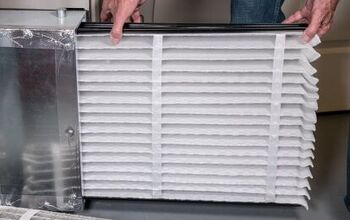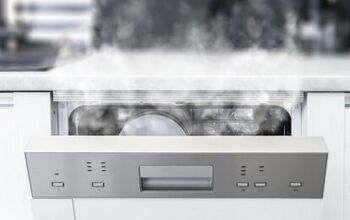Will Ice Maker Work Without Filter? (Find Out Now!)

Most modern refrigerators are outfitted with a water filter that’s connected to both the water dispenser and the ice maker – making it easy and convenient to always have access to clean, freshwater. If used on a regular basis, the filter will need replacing about every six months. Though, whether your filter has gone bad or you’ve decided to go filter-free, you may be wondering if your ice maker will still work without the filter.
Refrigerator ice makers (and water dispensers for that matter) will still work without a water filter, depending on the type of fridge you have. Provided that the fridge either has a built-in filter bypass mode or a filter bypass plug, the ice maker will function independently of the water filter.
We’ll walk you through exactly how to determine whether or not you’ll still be able to use your ice maker without a water filter, and, if possible, how to bypass it. Also, we’ll explore the importance of water filters and when it’s appropriate to go without one.
Do You Need Appliance Repair Services?
Get free, zero-commitment quotes from pro contractors near you.

Refrigerator Water Filter Basics
Refrigerator water dispensers and ice makers tend to function best when a filter is installed, as it allows them to consistently provide the best quality drinking water. Filters remove debris, minerals, and other impurities found in the water before it gets turned into ice. When unfiltered, foreign substances remain which will impact the taste and quality of the water.
Activated carbon filters are a common type that removes large foreign objects, such as particles and dirt, from your water via absorption. However, smaller particles can be ignored by carbon filters. For this reason, many homeowners opt for reverse osmosis filters, which have the ability to remove a wider variety of potentially harmful and unpleasant contaminants from your water. In fact, the reverse osmosis filtration method can remove up to 99 percent of contaminants.
If you’re unsure of the content or quality of your home’s water supply, a filter is recommended. It’s also important that you maintain your water filtration system appropriately and switch out the filter as needed.
Can I Run My Refrigerator Without a Filter?
Most refrigerators need to have their water filter changed about every six months. With this in mind, the cost to replace refrigerator filters can really start to add up. For some, this may be considered an unnecessary cost – especially if your home already has safe, clean, filtered water.
For instance, some homeowners choose to install a filtration system on their entire home, instead of just their refrigerator. If your water comes directly from a whole-house or reverse osmosis (RO) water filter system, you may not have to change your water filter as often, or at all.
Whether your water is already filtered with a whole-house system or you’re fortunate enough to have treated tap water, you may feel that it’s not necessary to have an additional filter in your fridge. In this case, you can actually save a ton of money and time on filter replacements by choosing to operate your fridge without a water filter.
How Refrigerator Ice Makers Function Without a Filter
A standard refrigerator comes outfitted with a water filter, which is responsible for removing impurities from your home water supply before it gets to your glass. Without a filter, the water will skip the filtration process and go right to both the ice maker and the water dispenser. Though, whether or not your refrigerator will still work without a filter will depend on the model.
Some refrigerator models require an additional component, known as a bypass plug, that allows you to skip the filtration step. This bypass plug must be properly installed for the ice maker to work without the filter. However, some refrigerators do not need this component. If your refrigerator does not have a bypass plug and you can close the filter housing with a filter cap, the filter is not required.
Always consult your refrigerator’s user manual for specifics regarding your model and how it operates without a water filter.
What is a Refrigerator Bypass Plug?
Most refrigerators that use a water filter feature a built-in bypass plug. When installed, this plug allows you to operate your refrigerator without a filter as needed– meaning your ice maker will still work.
The plug replaces the water filter inside of the filter housing, blocking the water from going into where the filter is normally installed. It essentially tricks your refrigerator into thinking that the filter is in position. With these refrigerator models, the bypass plug is typically installed in the refrigerator compartment.
How to Tell if You Need a Filter Bypass
To find out whether or not your particular refrigerator needs a filter bypass, follow these simple steps:
- Locate your water filter. The filter may be found in the grille at the bottom of the refrigerator, recessed into the door, in the upper left or right interior, lower left or right interior, or at the back of the fridge.
- Remove the water filter and attempt to use the ice maker and water dispenser.
- If the water dispenser and ice maker still work, then your refrigerator has a built-in automatic bypass mode. This means that you don’t have to purchase a filter bypass plug and you can continue on using your fridge without the water filter.
- However, if your ice maker and water dispenser don’t work, then you will need to obtain a filter bypass plug in order for your ice maker and water dispenser to function without a filter.
How to Bypass a Refrigerator Water Filter
To use a refrigerator bypass plug, all you have to do is detach the old water filter and install the bypass in the same way that you would attach a new filter. In most cases, you won’t have to shut off the water running to your fridge – unless you are bypassing an inline water filter at the back of your fridge.
How to Attach Filter Bypass Plug
After first removing the water filter, most refrigerator filter bypass plugs can be installed by either:
- Inserting the filter bypass plug into the housing and twisting a ¼ to ½ turn clockwise.
- Gently pushing the plug in, wiggling side to side.
- Pushing the bypass in until you hear a click, for water filters that have a push tab release.
Once the filter bypass is installed and the water is on, you’ll usually hear an audible click and/or a rush of water. This indicates that you installed the bypass correctly. Though, if you notice dripping water coming out of the bypass, it must be removed and cleaned to remove any debris that may be in the way. Clean both the bypass and the filter head.
How to Attach a Back-Of-The-Fridge Filter Bypass
Unfortunately, there isn’t really an official method for bypassing an inline-water filter found that the back of a fridge. However, what you’ll need is a ¼” to ¼” tube straight push connector. This will serve as the inline filter bypass. Depending on the amount of slack at the back of your fridge, you may need some additional tubing.
To install the push connector, simple cut the tubing next to the old filter and press the cut ends of the tubes into both ends of the connector.
Do You Need Appliance Repair Services?
Get free, zero-commitment quotes from pro contractors near you.

Related Questions
What happens if you don’t change the water filter in a refrigerator?
Failing to change the water filter in your fridge can result in scaling and deposit buildup in the water and ice machine. Over time, this can cause serious damage to your fridge. It will also slow down the entire system, cause low flow, and negatively impact the taste of your drinking water.
How often should you change your refrigerator water filter?
On average, it’s recommended that you change your refrigerator water filter every six months. However, this may vary based on the manufacturer and how often you use the water and ice dispenser.

Jessica considers herself a home improvement and design enthusiast. She grew up surrounded by constant home improvement projects and owes most of what she knows to helping her dad renovate her childhood home. Being a Los Angeles resident, Jessica spends a lot of her time looking for her next DIY project and sharing her love for home design.
More by Jessica Stone

























![Cost To Drill A Well [Pricing Per Foot & Cost By State]](https://cdn-fastly.upgradedhome.com/media/2023/07/31/9074980/cost-to-drill-a-well-pricing-per-foot-cost-by-state.jpg?size=350x220)

